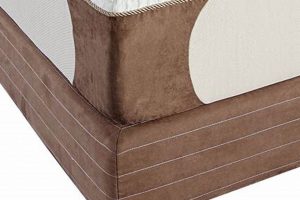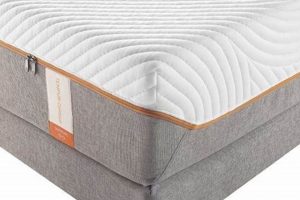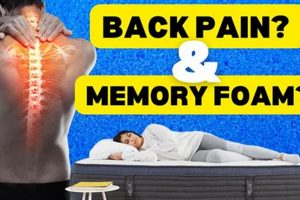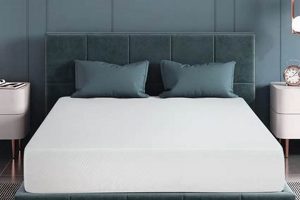The limitations associated with a specific type of bedding material, crafted from viscoelastic foam, encompass a range of considerations affecting user comfort and overall product satisfaction. These drawbacks can include issues with temperature regulation, potential off-gassing, and restricted movement capabilities for some individuals. For example, a user might experience overheating during sleep or find it difficult to change positions throughout the night due to the material’s conforming nature.
Understanding these factors is important for consumers to make informed purchasing decisions and to ensure that the selected sleep surface aligns with their personal needs and preferences. Historically, alternative bedding materials offered different combinations of support and comfort. Recognizing the less favorable aspects allows for a more complete evaluation compared to focusing solely on the positive marketing claims.
Therefore, a thorough examination of potential issues is crucial. The following sections will delve into specific areas, such as heat retention, odor concerns, and support characteristics, providing a balanced view of this widely used sleep technology.
Mitigating Concerns
This section provides strategies to minimize potential negative impacts associated with this particular sleep surface.
Tip 1: Ventilation Enhancement: Employ breathable bedding materials, such as cotton or linen sheets, to promote airflow and reduce heat retention within the mattress core.
Tip 2: Base Support Alternatives: Consider using a slatted bed frame or a platform with ample ventilation to facilitate air circulation beneath the mattress, further reducing trapped heat.
Tip 3: Initial Airing: Upon unpacking a new mattress, allow it to off-gas in a well-ventilated room for several days to dissipate volatile organic compounds that may contribute to unpleasant odors.
Tip 4: Mattress Protector Selection: Opt for a mattress protector designed for temperature regulation. These protectors often incorporate specialized fabrics to wick away moisture and enhance breathability.
Tip 5: Firmness Considerations: Individuals requiring more support might explore hybrid mattresses combining viscoelastic foam with innerspring coils or other supportive layers to address potential sinking or lack of spinal alignment.
Tip 6: Regular Rotation: Rotate the mattress regularly (e.g., every three to six months) to promote even wear and prevent localized compression, potentially extending its lifespan.
Tip 7: Zoned Support Options: Evaluate models featuring zoned support, which incorporate varying foam densities in different areas of the mattress to provide targeted support to specific body regions, enhancing comfort and spinal alignment.
By implementing these measures, individuals can potentially alleviate certain drawbacks and optimize their sleep experience with viscoelastic foam mattresses.
These strategies provide a proactive approach to maximizing comfort and minimizing potential problems. Further research into individual needs and preferences is recommended before purchase.
1. Heat Retention
Heat retention represents a significant limitation in some memory foam mattresses. The dense, viscoelastic structure, responsible for the material’s conforming properties, restricts airflow. This reduced airflow inhibits the dissipation of body heat, leading to an elevated sleep surface temperature. Consequently, individuals may experience discomfort, restlessness, and even night sweats.
The impact of heat retention varies depending on environmental conditions and individual physiology. In warmer climates or for individuals prone to overheating, this characteristic can exacerbate discomfort. Certain design elements, such as open-cell foam structures or infused cooling gels, attempt to mitigate this issue. However, their effectiveness remains variable and may not fully eliminate heat retention, depending on other factors such as room temperature and bedding materials. A practical example involves a consumer residing in a humid environment who finds that the elevated sleep temperature disrupts their sleep cycle, requiring them to adjust their thermostat or utilize cooling aids.
In summary, heat retention is a relevant consideration when assessing the suitability of a memory foam mattress. While technological advancements aim to improve airflow and thermal regulation, the inherent properties of viscoelastic foam present an ongoing challenge. Understanding the link between the material structure and heat retention is crucial for consumers to make informed decisions aligned with their individual sleep needs and environmental context.
2. Initial Odor
The emission of an initial odor is a frequently cited concern when discussing shortcomings associated with memory foam mattresses. This characteristic, while typically temporary, arises from specific manufacturing processes and material compositions, influencing the immediate user experience.
- Volatile Organic Compounds (VOCs)
The primary contributor to the initial odor is the release of VOCs. These compounds are byproducts of the chemical reactions involved in the creation of polyurethane foam. While most VOCs are considered harmless in low concentrations, their initial presence can produce a noticeable and potentially unpleasant scent. An example is the distinct “new car smell,” which is also attributed to VOCs, albeit within a different material matrix. The duration and intensity of this odor vary depending on the foam’s composition, manufacturing techniques, and ambient environmental conditions, like temperature and humidity.
- Manufacturing Residues
Certain manufacturing processes can leave residual chemical agents within the foam structure. These residues, used in the foaming, molding, or cleaning stages, can contribute to the initial odor. The extent of this contribution depends on the thoroughness of the post-production cleaning and treatment processes. Some manufacturers implement airing procedures to reduce residual chemical presence, yet a degree of initial odor may persist.
- Consumer Sensitivity
Individual sensitivity to odors differs significantly. Some individuals exhibit a heightened olfactory response, perceiving even minute concentrations of VOCs as strong or irritating. Conversely, others may be largely unaffected by the same odor level. This variance in sensitivity complicates the assessment of the severity of the odor and its impact on overall user satisfaction. Consequently, customer reviews often present conflicting accounts of the odor’s intensity and persistence.
- Mitigation Strategies and Certification
Several strategies aim to minimize initial odors, including extended airing
periods, specialized foam formulations with reduced VOC content, and the application of odor-absorbing treatments. Furthermore, certifications like CertiPUR-US verify that the foam has been tested and meets specific standards for VOC emissions and other potentially harmful substances. Such certifications provide a degree of assurance but do not guarantee the complete absence of an initial odor.
Ultimately, the initial odor represents a transient but potentially bothersome aspect of memory foam mattresses. While mitigation strategies and certification programs can reduce its impact, awareness of this characteristic allows consumers to factor it into their purchase considerations. The level of acceptance of this odor is highly subjective, highlighting the importance of balancing perceived drawbacks with potential benefits.
3. Motion Restriction
Motion restriction, as a facet of viscoelastic foam properties, presents a potential disadvantage in mattresses utilizing this material. Its conforming nature, designed to provide pressure relief, can simultaneously impede ease of movement. This characteristic warrants consideration when assessing the suitability of such mattresses for individuals with specific needs or preferences.
- Conforming Sinkage
The viscoelastic response of the foam causes it to contour closely to the body’s shape, creating a personalized indentation. While beneficial for pressure distribution, this “sinkage” effect can limit ease of repositioning during sleep. The user may experience a sensation of being enveloped by the mattress, requiring more effort to change sleeping positions. This can be particularly noticeable for individuals accustomed to freely shifting throughout the night.
- Energy Expenditure
Due to the conforming nature of the material, more energy is required to change positions. This is because the body has to overcome the resistance of the foam as it reforms to accommodate the new position. For individuals with mobility limitations or those experiencing fatigue, this increased energy expenditure can be a significant drawback. For example, an elderly person or someone recovering from surgery might find the effort needed to turn in bed uncomfortable or even painful.
- Perceived Trapping
The sensation of being “trapped” within the mattress can be psychologically unsettling for some users. This perceived limitation of movement may lead to feelings of claustrophobia or anxiety, even if the actual degree of restriction is minimal. This subjective experience can negatively impact sleep quality and overall comfort, independent of any physical limitations.
- Edge Support Compromise
While not directly motion restriction, reduced edge support can exacerbate issues. If the edge collapses easily under pressure, it can increase the sensation of being confined within the mattress’s central area. This is particularly relevant for individuals who tend to sleep near the edge of the bed or who rely on the edge for support when getting in or out of bed.
In conclusion, motion restriction presents a tangible drawback associated with viscoelastic foam mattresses. The degree of this limitation varies based on foam density, mattress construction, and individual user characteristics. Awareness of this potential impediment allows consumers to evaluate their personal priorities and make informed decisions aligned with their comfort and mobility requirements.
4. Weight limitations
Exceeding designated weight limits poses a significant contributor to the detriments associated with memory foam mattresses. This limitation directly impacts structural integrity and lifespan, leading to premature degradation and reduced support capabilities. The inherent properties of viscoelastic foam make it susceptible to compression under sustained pressure, and exceeding weight capacities accelerates this process. The result is often localized sagging, particularly in areas bearing the most concentrated weight, leading to uneven sleep surfaces and compromised spinal alignment. This is especially relevant for couples or individuals with higher body mass indices, as the accumulated pressure can overwhelm the mattress’s support system. Manufacturers typically specify maximum weight guidelines to mitigate these issues; however, exceeding these recommendations directly correlates with diminished performance and longevity of the product.
The practical implications extend beyond mere comfort. Insufficient support can exacerbate existing musculoskeletal issues, contributing to back pain, joint stiffness, and disrupted sleep. For example, a mattress designed to support a combined weight of 500 pounds might exhibit significant sagging and reduced support within a year if regularly subjected to 700 pounds. This degradation also reduces the mattress’s ability to properly distribute weight, leading to increased pressure points and potential discomfort. Selecting a mattress with an appropriate weight capacity, or opting for models reinforced with high-density foams or innerspring systems, becomes crucial to prevent premature wear and maintain optimal support. Regular inspection for signs of compression or sagging is also advisable to address potential issues before they escalate into more significant problems.
In summary, weight limitations represent a critical factor influencing the durability and effectiveness of memory foam mattresses. Adhering to manufacturer-specified weight guidelines is essential to preserve structural integrity and avoid premature degradation. Ignoring these limits can lead to compromised support, increased discomfort, and reduced lifespan, ultimately diminishing the overall value and benefits derived from the product. Consideration of these limitations constitutes a necessary element of informed consumer decision-making when selecting a memory foam mattress.
5. Sagging potential
The propensity for sagging represents a significant disadvantage inherent in memory foam mattresses. The viscoelastic nature of the material, while contributing to its conforming properties, also renders it susceptible to permanent compression under sustained weight. This characteristic poses a notable long-term limitation, influencing comfort, support, and overall lifespan. Sagging occurs when the foam’s cell structure breaks down, resulting in a visible indentation that fails to fully recover, even when weight is removed. This phenomenon directly undermines the mattress’s capacity to provide consistent spinal alignment and pressure relief. For instance, a mattress with a pronounced sag in the lumbar region will no longer adequately support the lower back, potentially exacerbating back pain and contributing to poor sleep posture. The rate at which sagging occurs is influenced by factors such as foam density, user weight, and the quality of the mattress’s supporting core.
The impact of sagging extends beyond mere aesthetic concerns. A sagging mattress can disrupt sleep patterns, leading to restlessness and fatigue. The uneven surface compromises proper weight distribution, resulting in concentrated pressure points that can cause discomfort and impede circulation.
Furthermore, sagging can create a “roll-together” effect, particularly in mattresses shared by two individuals, where both sleepers tend to gravitate towards the center of the bed, further exacerbating the problem. The financial implications are also noteworthy, as mattresses exhibiting premature sagging often require replacement sooner than anticipated, incurring additional costs for the consumer. Manufacturers attempt to mitigate this issue through various construction techniques, such as incorporating high-density foams or reinforced support cores. However, even with these measures, sagging remains a potential risk, particularly in lower-quality or excessively used mattresses.
In summary, sagging potential represents a critical consideration when evaluating the disadvantages of memory foam mattresses. The long-term effects of sagging negatively impact support, comfort, and sleep quality, thereby diminishing the overall value of the product. While preventive measures can delay its onset, an inherent susceptibility to permanent compression remains a characteristic challenge. Consumers should carefully consider foam density, construction quality, and warranty provisions to minimize the risk of premature sagging and maximize the longevity of their mattress investment.
Frequently Asked Questions
This section addresses common inquiries and concerns related to potential drawbacks associated with a specific type of bedding.
Question 1: Does every viscoelastic foam mattress exhibit heat retention to a significant degree?
No. While heat retention is a potential characteristic, design variations and material advancements mitigate this issue in some models. Open-cell structures and infused cooling gels can improve airflow and reduce heat accumulation. However, individual experiences may vary.
Question 2: How long does the initial odor from a new viscoelastic foam mattress typically last?
The duration of the initial odor is variable. It generally dissipates within a few days to a couple of weeks, depending on the specific formulation of the foam and the ventilation of the environment. Airing the mattress in a well-ventilated space accelerates the process.
Question 3: Are motion restriction issues prevalent across all viscoelastic foam mattresses, regardless of density?
The degree of motion restriction depends on the foam density and mattress construction. Higher-density foams typically exhibit greater conforming sinkage, which can increase the sensation of limited movement. Lower-density foams or mattresses with supportive coil systems may offer greater ease of repositioning.
Question 4: Is exceeding the manufacturer’s weight limit on a viscoelastic foam mattress guaranteed to cause damage?
Exceeding the weight limit significantly increases the risk of premature degradation and sagging. While not immediate, sustained overloading accelerates compression and compromises the mattress’s structural integrity over time.
Question 5: What measures can be taken to minimize the sagging potential of a viscoelastic foam mattress?
Rotating the mattress regularly, using a supportive bed frame, and ensuring compliance with the manufacturer’s weight recommendations can help minimize sagging. Selecting a high-density foam mattress with a robust support core also contributes to increased durability.
Question 6: Are there specific health concerns associated with the volatile organic compounds (VOCs) emitted from viscoelastic foam mattresses?
Most VOCs released from memory foam are considered harmless in low concentrations. However, individuals with heightened sensitivities or respiratory conditions may experience irritation. Certifications such as CertiPUR-US ensure that the foam meets specific standards for VOC emissions and harmful substances.
Understanding potential limitations allows for informed purchasing decisions and proactive mitigation efforts, optimizing the long-term performance and comfort of the sleep surface.
Considerations for addressing specific concerns, such as heat regulation and support enhancement, will be discussed in subsequent sections.
Disadvantages of Memory Foam Mattress
This exploration has detailed several potential limitations associated with viscoelastic foam mattresses. These drawbacks encompass issues related to thermal regulation, off-gassing potential, restricted movement, weight limitations, and the propensity for long-term sagging. Each of these factors carries implications for overall comfort, support, and the longevity of the sleep surface, demanding careful consideration by potential buyers.
The information presented underscores the necessity of thorough research and informed decision-making when selecting bedding. While viscoelastic foam offers certain benefits, a comprehensive understanding of its inherent shortcomings allows consumers to align their purchasing choices with individual needs and priorities. Continued advancements in materials and manufacturing processes may mitigate some of these disadvantages; however, awareness remains critical for ensuring satisfaction and maximizing the investment in a sleep solution.



![Best Memory Foam Camper Mattress [Deals!] Organic & Natural Mattress Buyer’s Guide: Non-Toxic Sleep Solutions Best Memory Foam Camper Mattress [Deals!] | Organic & Natural Mattress Buyer’s Guide: Non-Toxic Sleep Solutions](https://mattressworldpa.com/wp-content/uploads/2025/07/th-4035-300x200.jpg)

![Best Memory Foam Futon Mattress for Comfy Sleep [Guide] Organic & Natural Mattress Buyer’s Guide: Non-Toxic Sleep Solutions Best Memory Foam Futon Mattress for Comfy Sleep [Guide] | Organic & Natural Mattress Buyer’s Guide: Non-Toxic Sleep Solutions](https://mattressworldpa.com/wp-content/uploads/2025/07/th-4033-300x200.jpg)

